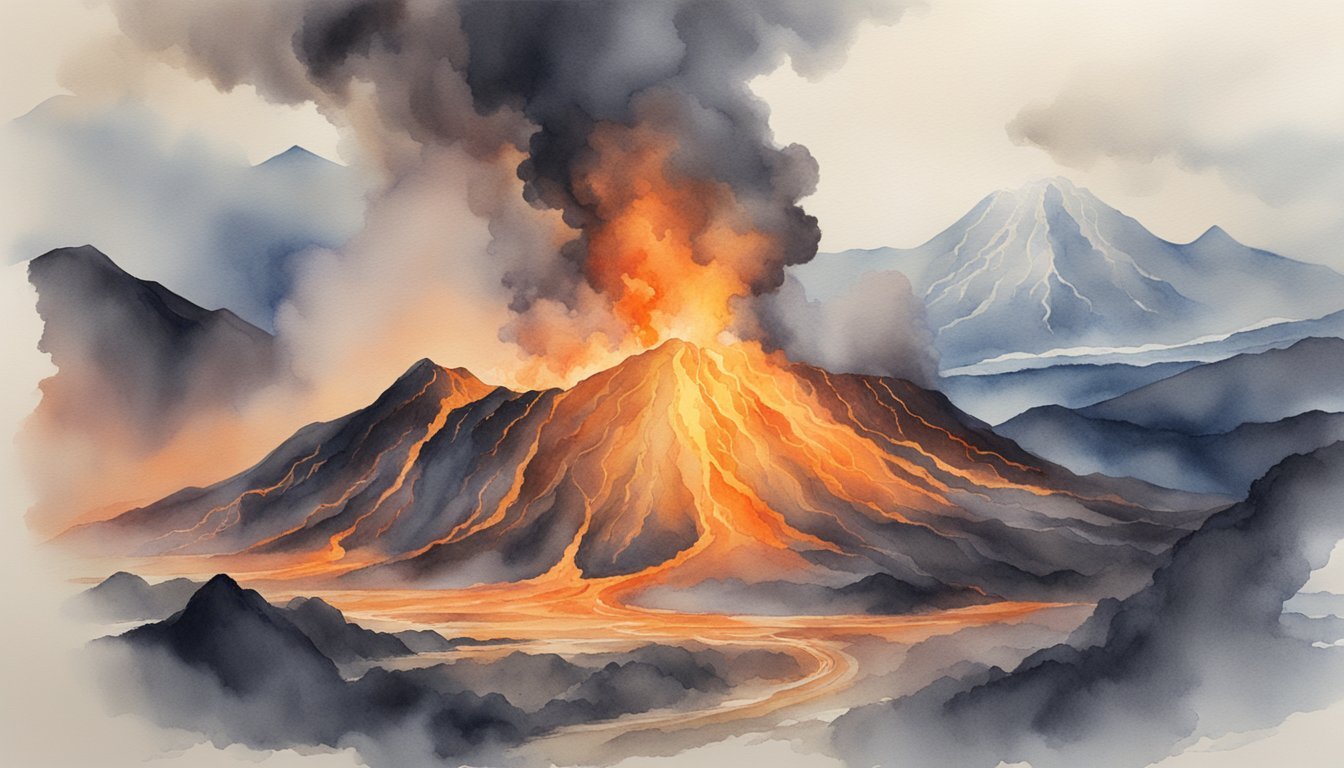Understanding Volcanoes
Volcano Formation and Types
Volcanoes are formed when molten rock, hot gases, and other materials erupt through an opening in a planet or moon’s crust, often creating a hill or mountain as layers of rock and ash build up from repeated eruptions1. This process occurs when magma from the Earth’s mantle rises to the crust, usually due to the movement of tectonic plates2. There are three main types of volcanoes: shield volcanoes, stratovolcanoes, and cinder cones3.
Shield volcanoes are characterized by broad, gentle slopes created by lava flows4. These volcanoes produce large volumes of lava during eruptions, forming extensive lava fields. An example of a shield volcano is Mauna Loa in Hawaii5.
Stratovolcanoes, also known as composite volcanoes, are steep-sided, cone-shaped volcanoes6. They are formed from layers of lava flows, ash, and other debris, which are deposited during alternating explosive and effusive eruptions. One of the most famous stratovolcanoes is Mount Fuji in Japan7.
Cinder cones are the smallest and most common type of volcano8. They are typically composed of loose volcanic rock fragments called cinders and usually have a short lifespan. A well-known cinder cone volcano is Paricutin in Mexico9.
Famous Volcanic Mountains
There are many famous volcanic mountains around the world, showcasing the different characteristics and behaviors of volcanoes. Some examples include:
- Mount St. Helens in the United States, a stratovolcano that erupted violently in 1980, causing massive destruction and reshaping the surrounding landscape10.
- Krakatoa in Indonesia, another stratovolcano known for its 1883 eruption that had the loudest sound ever recorded in human history and was catastrophic for the global climate11.
- Eyjafjallajökull in Iceland, a glacier-covered stratovolcano that erupted in 2010, disrupting air travel worldwide as ash plumes spread across Europe12.
Understanding volcanoes and their various types helps us to appreciate the diversity and power of Earth’s natural forces, as well as how volcanoes have shaped landscapes and continue to impact people’s lives around the world.
Volcanic Impact on Earth and Beyond

Effects on Earth’s Landscape
Volcanic eruptions have significantly shaped the Earth’s landscape, resulting in the formation of many unique geological features. They are responsible for releasing molten rock, or lava, from deep within the Earth, which then cools and solidifies to form new rock on the Earth’s surface1. One such example is the creation of islands, which are formed when underwater volcanic vents erupt and produce enough lava to break through the ocean’s surface.
Volcanic activity is typically concentrated within specific regions, such as the Ring of Fire that encircles the Pacific Ocean. This area is characterized by frequent earthquakes, active volcanoes, and tectonic plate movements, making it one of the most volcanically active regions on our planet2.
Volcanoes can also have a significant impact on the climate. During major eruptions, they release large amounts of gases and ash into the atmosphere. By doing so, they can change the chemical composition of the atmosphere and potentially lead to temporary cooling of the Earth’s surface3.
Volcanoes Beyond Earth
Interestingly, volcanic activity is not limited to Earth. Other celestial bodies within our solar system also exhibit signs of volcanic activity. For example, our very own Moon has been found to contain evidence of past volcanic eruptions in the form of solidified lava flows and volcanic cones.
Planets such as Venus and Mars have also been observed to have volcanic features, suggesting that volcanic activity has played a role in shaping their landscapes as well. While evidence of present-day volcanism is scarce, these observations help us better understand the geological history and evolution of other planets within our solar system4.
Volcanic activity beyond Earth offers unique opportunities to explore the similarities and differences between our home planet and distant worlds. By studying volcanoes on Earth, the Moon, and other planets, we can gain valuable insights into the geological processes that shape and transform these celestial bodies over time.

